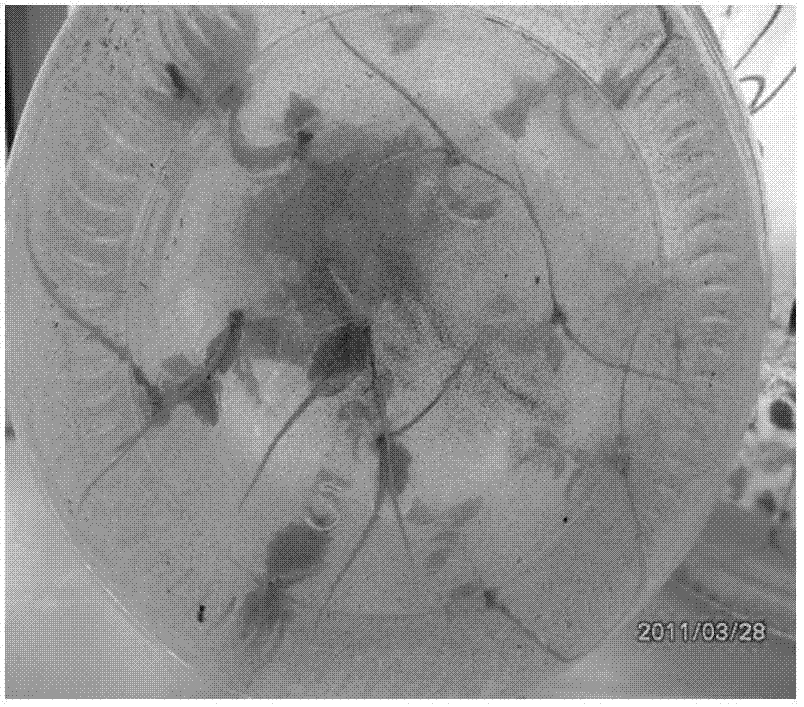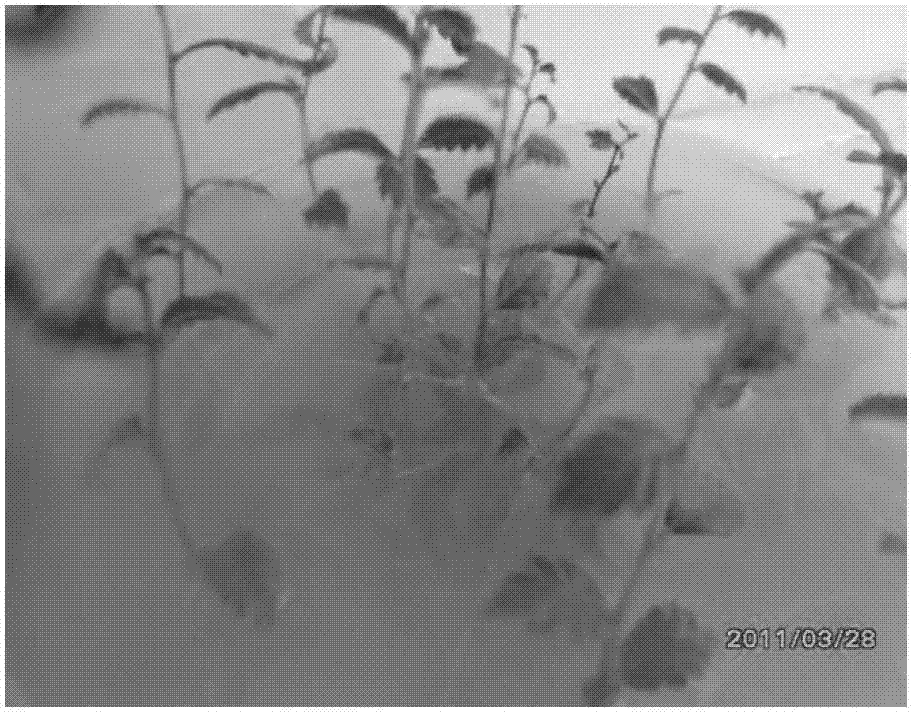In-bottle rooting method for salt tolerance ulmus pumila tissue culture seedling
A technology for tissue culture seedlings and salt tolerance is applied in the field of in-bottle rooting of salt-tolerant white elm tissue culture seedlings, which can solve the problems of low survival rate, difficult rooting and high cost.
- Summary
- Abstract
- Description
- Claims
- Application Information
AI Technical Summary
Problems solved by technology
Method used
Image
Examples
Embodiment 1
[0038] The subcultured salt-tolerant elm tissue culture seedlings were selected, and the selection standard was a single elm seedling with a height of 2-3.5cm, robustness, and stretched leaves;
[0039] The salt-tolerant white elm tissue culture seedling of selected subculture is inoculated on the WPM rooting medium;
[0040] Wherein, the WPM rooting medium is a 1 / 2 WPM rooting medium which is reduced by 1 / 2 with a large amount of elements in the WPM basic medium.
[0041] The auxin is indole butyric acid (IBA), and its final concentration is 0.05 mg / L; the cytokinin is naphthalene acetic acid (NAA), and its final concentration is 0.05 mg / L; the exogenous addition The substances are activated carbon (AC) and white sugar, the final concentration of the activated carbon (AC) is 0.2g / L, and the final concentration of the white sugar is 20g / L.
[0042] The pH value of the WPM rooting medium was 5.8.
[0043] Twenty-five days after inoculation, the rooting rate was counted.
Embodiment 2
[0045] The subcultured salt-tolerant elm tissue culture seedlings were selected, and the selection standard was a single elm seedling with a height of 2-3.5cm, robustness, and stretched leaves;
[0046] The salt-tolerant white elm tissue culture seedling of selected subculture is inoculated on the WPM rooting medium;
[0047] Wherein, the WPM rooting medium is a 1 / 2 WPM rooting medium which is reduced by 1 / 2 with a large amount of elements in the WPM basic medium.
[0048] The auxin is indole butyric acid (IBA), and its final concentration is 0.2 mg / L; the cytokinin is naphthalene acetic acid (NAA), and its final concentration is 0.1 mg / L; the exogenous addition The substances are activated carbon (AC) and white sugar, the final concentration of the activated carbon (AC) is 0.5g / L, and the final concentration of the white sugar is 30g / L.
[0049] The pH value of the WPM rooting medium was 5.85.
[0050] Twenty-five days after inoculation, the rooting rate was counted.
Embodiment 3
[0052] The subcultured salt-tolerant elm tissue culture seedlings were selected, and the selection standard was a single elm seedling with a height of 2-3.5cm, robustness, and stretched leaves;
[0053] The salt-tolerant white elm tissue culture seedling of selected subculture is inoculated on the WPM rooting medium;
[0054] Wherein, the WPM rooting medium is a 1 / 2 WPM rooting medium which is reduced by 1 / 2 with a large amount of elements in the WPM basic medium.
[0055] The auxin is indole butyric acid (IBA), and its final concentration is 0.3 mg / L; the cytokinin is naphthalene acetic acid (NAA), and its final concentration is 0.2 mg / L; the exogenous addition The substances are activated carbon (AC) and white sugar, the final concentration of the activated carbon (AC) is 2g / L, and the final concentration of the white sugar is 40g / L.
[0056] The pH value of the WPM rooting medium was 5.9.
[0057] Twenty-five days after inoculation, the rooting rate was counted.
PUM
 Login to View More
Login to View More Abstract
Description
Claims
Application Information
 Login to View More
Login to View More - R&D
- Intellectual Property
- Life Sciences
- Materials
- Tech Scout
- Unparalleled Data Quality
- Higher Quality Content
- 60% Fewer Hallucinations
Browse by: Latest US Patents, China's latest patents, Technical Efficacy Thesaurus, Application Domain, Technology Topic, Popular Technical Reports.
© 2025 PatSnap. All rights reserved.Legal|Privacy policy|Modern Slavery Act Transparency Statement|Sitemap|About US| Contact US: help@patsnap.com



